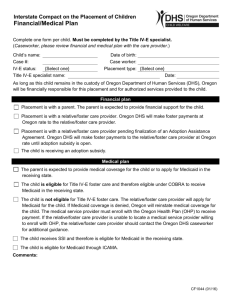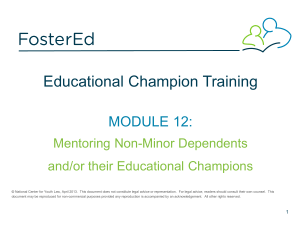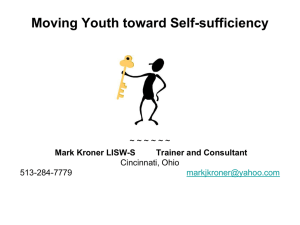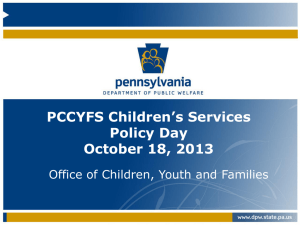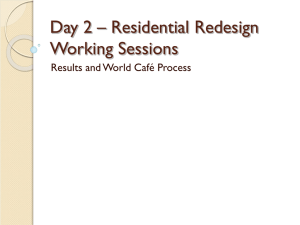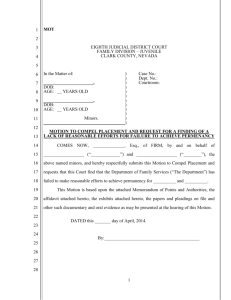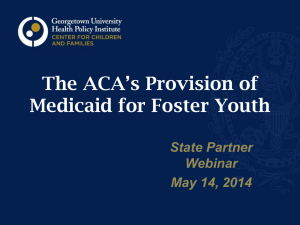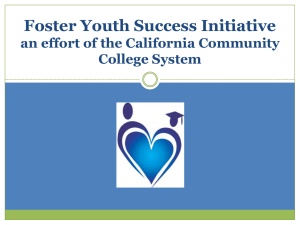Extension of Foster Care - Jim Casey Youth Opportunities Initiative
advertisement
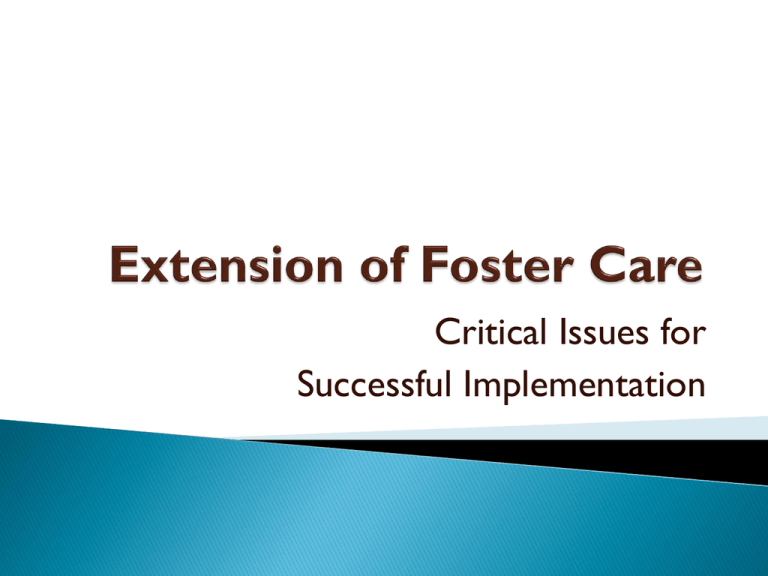
Critical Issues for Successful Implementation Samanthya Amann, Iowa Nicole Byers, Delaware Kate Hanley, Consultant with the NRCYD Alabama Arkansas D.C. Illinois Maryland Minnesota Nebraska New York Oregon Eight of the nine programs extend foster care to age 21 and allow all of the eligible groups to participate (education, work, career, medical). Nebraska allows all eligible groups but extends foster care to age 19. Massachusetts Tennessee Texas W. Virginia All states extend to age 21 - Massachusetts and Texas for all groups. Tennessee will extend to age 21 for the education group and medical. W. Virginia to age 21 for education and career planning groups. Arizona, California, Florida, Indiana, Louisiana, Michigan, North Dakota and Washington plan to implement. 5 states will extend to 21. California will extend to 19 on 1/1/12, to age 20 on 1/1/13, and 21 on 1/1/14 with legislative approval. Indiana is planning on a maximum age of 20, allowing for a year of Chafee services prior to the young adult transitioning. Fiscal impact Extension includes Medicaid and this will be a new covered group for many states. Extension of court jurisdiction incurs costs and additional personnel. States that are county administered challenged by local budget issues. Need for fiscal analysis to determine costs and benefits. The young adult population, 18 and older, must be in foster care under the responsibility of the title IV-E agency. If a title IV-E agency determines the age of the foster care extension beyond 18 this must apply to adoption and guardianship assistance (if occurred after attaining age 16). The agency must change the definition of “child”, for the purpose of the title IV-E programs, to the maximum age chosen for the extension. Annual permanency hearings must be held by the court unless the young adult is in foster care under a voluntary agreement. Periodic reviews must be held by court or approved board. Monthly caseworker visits must be conducted and reported. All young adults in title IV-E funded foster care are categorically eligible for Medicaid. Young adults with children - requirement to cover the costs of the child in a foster family home, child care institution, or supervised independent living setting is in effect and the child is categorically eligible for Medicaid. Permanency - efforts must continue to assist young adults in developing permanent connections with caring adults. Young Adult must meet one of the following: Completing high school or equivalency. Is enrolled in a college, university, trade or vocational school. Is participating in a program or activity to promote employment or remove barriers. Is employed at least 80 hours per month. Is incapable of doing any of the above due to a medical condition. Maximum Age up to 21 Conditions of Eligibility Court Hearing and Periodic Review Process Reentry/Trial Independence Approved Living Arrangements Maintenance payments direct to young adult Permanency Planning – Adoption after age 18 with assistance Foster care with current policies will not provide age appropriate options. All stakeholders must acknowledge and respect the “adult” status after age 18. Program must be supportive and based on authentic young adult involvement – either they are given the ability to make decisions or they will decide to leave. Need to include all eligibility conditions. Must have flexible programming and build “social capital” to ensure all young adults can benefit from extension of foster care. Chapin Hall Report of Subpopulations Ensure services are individualized to meet needs. Recognize struggling young adults who lack social capital, face mental health and substance abuse issues. Pregnant and Parenting - need advocacy, support and programs to address specific issues. Program Instructions encourage agencies to be “innovative”. Living arrangement should: ◦ Be developmentally appropriate. ◦ Recognize the need for independence. ◦ Respect the young adults right to make decisions. ◦ Allow for young adult to live in an unlicensed setting with supervision. Each young adult defines permanency in a unique way. Agency must support efforts to establish positive relationships. Return to family. Adoption after age 18. Young adult will make new connections. Becoming a “couple”. Payments made to young adults living in unlicensed supervised settings. Title IV-E agency may (but is not required to) pay all or part of the foster care maintenance payment directly to the youth. Young adults must learn to develop budgets and to pay bills. It is about “readiness” to live on their own. Reentry and Trial Independence are critical elements that states must think through carefully. Many young adults will want to try it on their own – safety net must be provided. There should not be limitations on reentry – young adults must sign a voluntary foster care agreement and meet requirements when reentering. Some young adults don’t want to go to court after age18 - hasn’t been a positive experience in their life. Allowance for another type of “hearing” through a court approved board (fcrb, casa, etc.) that is responsive to the needs of young adults and provides reports to the court. If young adult has a positive relationship with the Judge or Hearing Officer should have option to continue with hearings. For younger children in foster care the Guardian Ad Litem advocates for what they believe is in the child’s best interest. For young adults, the relationship must become client driven. The attorney must represent what the young adult defines as being in their best interest. This change in relationship empowers the young adult to make decisions and take responsibility for their life. How does a state develop policy and practice guidelines that allow the young adult to make decisions while ensuring that the caseworker/foster parent are not held responsible for the consequences that may result? What if a young adult doesn’t pay rent and make appropriate decisions? How can we determine if they are ready to handle the responsibilities? Agencies will want to educate the public and stakeholders about the extension prior to implementation. If public understands the importance of allowing young adults to make decision there will be more acceptance of issues that may arise. Work to develop community buy-in and support for the program through young adult presentations. 1. 2. 3. 1. 2. Jim Casey Reports: The Adolescent Brain: New Research and Its Implications for Young People Transitioning From Foster Care Foster Care to 21: Doing It Right Social Capital: Building Quality Networks for Young People in Foster Care Fosteringconnections.org Designing Foster Care to 21: A Discussion Guide for State Leaders Number of Youth Aging Out of Foster Care Drops below 28,000 in 2010
